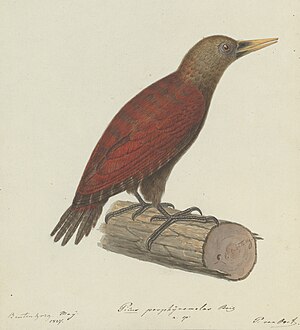Chestnut woodpecker
| Chestnut woodpecker | ||||||||||
|---|---|---|---|---|---|---|---|---|---|---|

Chestnut woodpecker ( Blythipicus rubiginosus ) |
||||||||||
| Systematics | ||||||||||
|
||||||||||
| Scientific name | ||||||||||
| Blythipicus rubiginosus | ||||||||||
| ( Swainson , 1837) |
The Maron Woodpecker ( blythipicus rubigenosus ) is a species of bird from the family of woodpeckers (Picidae). This small and generally very darkly colored woodpecker lives in large parts of Southeast Asia. The species is closely tied to the forest with dense and not very translucent undergrowth, where it is usually only a few meters above the ground. The diet consists mainly of larvae of wood-dwelling beetles and other insect larvae. In large parts of its large distribution area, the species is considered to be rare to common, but the population is apparently decreasing. The IUCN classifies the chestnut woodpecker as “least concern”.
description
Chestnut woodpeckers are small woodpeckers with a short tail and a long, straight, chisel-shaped, pointed beak that is broad at the base. The body length is about 23 cm, the weight 64–92 g. They are about the size of a great spotted woodpecker . The species shows a not very conspicuous sexual dimorphism in terms of coloration , females also have a shorter beak than the males.
These woodpeckers are - probably in adaptation to their low-light habitat - overall very monochrome, dark brown to red-brown. In the male, the back, rump, and upper tail-coverts are brown and dark rusty brown. The feathers therefore have one or two indistinct bands at the base. The upper wing-coverts are dark brownish red and often show some arrowhead-like markings near the tips. The wings are dark brown with dark reddish seams and tips and narrow and indistinct pale whitish light beige bands. The control feathers are dark brown and also indistinctly lightly banded. The entire underside of the trunk is a single color, dark smoky brown to blackish, occasionally there are some feathers with red tips on the chest. The lower wings are dark brown, the lower tail is a little lighter brown than the upper side of the tail. The head is almost monochrome, dark olive-brown, the forehead is somewhat lighter. The sides of the neck and often also the sides of the back of the head are blood red, occasionally red feathers can also be found in the cheek region. The throat is dark brown and slightly separated from the darker body.
The beak is pale yellow or ivory to yellow, greenish yellow at the base, in females often even blackish. Legs and toes are gray or gray-brown to blackish. The iris is dark red to brownish red, brown in young birds.
Females lack the red areas on the sides of the neck and back of the head. These areas are dark olive-brown like the rest of the head, but often show a dark reddish tone. The intraspecies variability is low and no subspecies are recognized.
Vocalizations
The most frequent calls are metallic, single, double or lined up “pit” or “pjick” sounds. A series of 7 to 11 or more loud, sloping longer calls such as "chai-chai-chai-chai ..." is typical of the species . It is not yet known whether chestnut woodpeckers drum.
distribution and habitat
This species of woodpecker inhabits large parts of Southeast Asia. The distribution area extends in a west-east direction from northwest Sumatra to the east of Borneo , in north-south direction from the south of Myanmar and Thailand to the southern tip of Sumatra. The size of the total distribution area is not exactly known.
Chestnut woodpeckers are closely tied to forests with dense and less translucent undergrowth. They mainly inhabit the evergreen rainforest with dense ground vegetation, but also correspondingly structured secondary forests , bamboo forests and rubber tree plantations . The animals are largely restricted to lowlands, but occur in Thailand up to an altitude of 900 m and on Sumatra and Borneo up to an altitude of 2200 m.
Way of life
The species is usually only a few meters above the ground, rarely higher than 6 m and usually only climbs a few meters on trees. The food sought on both living trees and lying and standing, decaying dead wood of all sizes consists primarily of larvae of wood-dwelling beetles and other insect larvae. The birds remove moss and litter with their beak and chop rotting wood into small pieces with their strong beak.
Chestnut woodpeckers live individually or in pairs. The breeding season in Malaysia extends from December to May. Nests were found on Borneo in January, but the breeding season there probably extends to August. The caves are partly created on the edges of dense trees. Further information on the breeding biology is not yet available.
Existence and endangerment
There is no information on the size of the population. In large parts of its large distribution area, the species is considered to be rare to common, but the population is apparently decreasing. The IUCN classifies the chestnut woodpecker as “least concern”.
swell
Individual evidence
- ↑ BirdLife International (2010) Species factsheet: Blythipicus rubiginosus . ( Online , accessed September 7, 2010)
literature
- Hans Winkler , David Christie and David Nurney: Woodpeckers. A Guide to the Woodpeckers, Piculets, and Wrynecks of the World. Pica Press, Robertsbridge 1995, ISBN 0-395-72043-5 , pp. 158-159 and 383.
Web links
- Blythipicus rubigenosus in the endangered Red List species the IUCN 2009. Posted by: BirdLife International, 2009. Retrieved on 7 September, 2010.
Other web links
- Videos, photos and sound recordings for Blythipicus rubiginosus in the Internet Bird Collection
- Photos of Blythipicus rubiginosus in the Oriental Bird Club image database , accessed September 13, 2010